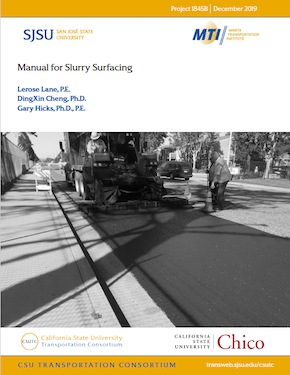- 408-924-7560
- mineta-institute@sjsu.edu
- Donate
Manual for Slurry Surfacing
Slurry surfacing, which includes slurry seals and microsurfacing, is just one type of many maintenance treatments that can preserve pavements and defer the need for and cost of a reconstruction project. Slurry seals, which were developed first, are placing on an existing pavement. They proved to be a promising technique in maintaining road surfaces. Currently, slurry seals are used for a multitude of surfacing projects throughout the world, and are accepted as a cost-effective maintenance treatment.
Microsurfacing, first developed in the 1960s, is an improved version of a slurry seal. Microsurfacing uses a more complex form of slurry surfacing involving special “engineered” polymer-modified Quick Setting (QS) asphalt. Over time, the goals were met with specialized mixes that are able to address more severe distresses with a faster set time. Microsurfacing is now widely used throughout the United States.
Slurry surfacing, as a pavement preservation treatment, provides an economical means for maintaining and improving the functional condition of an existing pavement. This manual presents the best practices for construction of slurry surfacing which includes guides for trouble shooting problems. Besides project selection, a types of slurry surfacing, construction issues, and the design process for slurry surfacing are also covered in this manual.
LEROSE LANE, PE
Lerose Lane PE, is a Senior Pavement Preservation Engineer, who has worked for the California Pavement Preservation Center (CP2C) since August 2010. Her work includes observing pilot project construction for a wide variety of preservation strategies including: Rubberized Chip Seals, Scrub Seals, Reconstruction with Rubberized Hot Mix Asphalt Concrete, and Double Chip Seals. Besides observing and evaluating construction and long-term performance of this wide variety of preservation strategies, she co-authors many of the technical reports regarding the construction phases and the follow up inspection reports. Most of these projects are Caltrans projects on State Highways or Interstate routes. She graduated from CSU, Chico, in 1970 with a BS degree in Civil Engineering. Since that time, she has worked for UCD, City of Marysville, County of Tehama, and Caltrans in various capacities including: District Materials Engineer, Office Chief in Design, Senior Construction Engineer, as well as a Resident Engineer for a wide variety of projects. She has been a Professional Engineer in the State of California since 1975.
DINGXIN CHENG, PhD, PE (TEXAS)
Dr. DingXin (Ding) Cheng is a professor of the department of civil engineering at the California State University, Chico, director of the California Pavement Preservation (CP2) Center, and the director of the Tire Derived Aggregate Technology Center. He has worked actively with the CP2 Center since he joined the department of civil engineering of CSU Chico in 2006. He obtained his PhD in the areas of pavement materials and transportation from Texas A&M University in College Station, Texas in 2002. He worked in private industry for Parsons Brinckerhoff in Houston, TX before joining the Chico State University. He has extensive experiences in Hot Mix Asphalt (HMA) materials and pavement preservation on both asphalt and concrete pavements. He has more than 55 peer-reviewed publications related to pavement materials and preservation in Transportation Research Board, AAPT, ASCE, and other conferences. Ding has co-managed or managed more than $7 million research projects funded by California Department of Transportation (Caltrans), California Department of Resources Recycling and Recovery (CalRecycle), Metropolitan Transportation Commissions (MTC) of San Francisco Bay Area, and other agencies and industry.
R. GARY HICKS, PhD, PE
Dr. Hicks is currently program manager for the CP2 Center at CSU Chico. Prior to joining the Center, he taught at Georgia Tech and Oregon State University for 30 years rising to a Distinguished Profess of Civil Engineering and the Associate Dean for Research for the College of Engineering. He retired from OSU in 1997, and upon retirement embarked on a consulting career with MACTEC Engineering (now Wood LLC) providing on call consulting services to the California Department of Transportation, and other organizations. As a part of this project he led the development of the MTAG and helped set of the CP2 Center in 2006. He is a registered Civil Engineer in the states of California, Oregon and Alaska.
-
Contact Us
San José State University One Washington Square, San Jose, CA 95192 Phone: 408-924-7560 Email: mineta-institute@sjsu.edu






